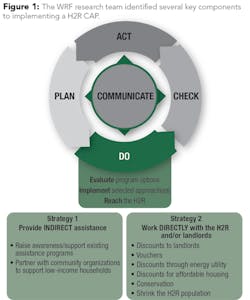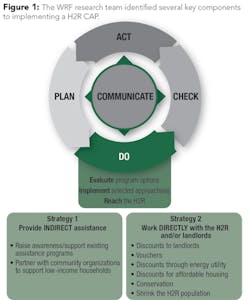Addressing affordability through customer assistance programs
By Kelsey Beveridge
Affordability of services is a growing concern for water and wastewater utilities across the country. Utilities are responsible for maintaining infrastructure needs while meeting national regulations and ensuring customers have a safe, affordable water supply. To achieve this balance, utilities are exploring customer assistance programs (CAPs) to not only maintain revenue reliability but also support low-income customers. There are successful examples of CAPs that demonstrate multiple benefits to utilities and alleviate stressors for customers. However, legal and regulatory frameworks can be confusing and inconsistent across state lines, making funding sources for CAPs unclear. The Water Research Foundation (WRF) has two studies dealing with legal and regulatory barriers for CAPs and using CAPs to target hard to reach (H2R) customers.
Funding for CAPs
Arguably the most important limitation to the establishment of CAPs is funding. Many states have different rules for different types of utilities. For example, the rules may differ between water or wastewater utilities, or government-owned versus privately owned utilities. Due to the variation and often confusing regulations around the design of CAPs, many programs are small, with a limited capacity to help customers.
A research project led by the National Association of Clean Water Agencies (NACWA) and co-funded by WRF, Navigating Legal Pathways to Rate-Funded Customer Assistance Programs: A Guide for Water and Wastewater Utilities, aimed to help facilitate planning by identifying the current state of regulations. The guide ultimately helps utilities and affiliated organizations understand the regulatory framework and influence of how CAPs are funded.
The U.S. Environmental Protection Agency (EPA) published a compendium categorizing CAPs into five types: bill discount, flexible terms, lifeline rate, temporary assistance, and water efficiency. However, it provides little guidance to states’ legal framework that impacts program feasibility and funding sources.
The NACWA/WRF research team evaluated each state’s statutory and regulatory framework, and identified three primary legal issues that were thematic among all states. The most prominent is the absence of judicial interpretation of statutory terminology. For example, common language states that water and wastewater utility rates must be “reasonable” or “justifiable.” Depending on context and interpretation, this can vary significantly between utilities.
Another legal barrier is that many states have constitutional gift clauses that limit government entities from granting subsidies to individuals, associations, or corporations. In most states, utilities have some flexibility if funding for CAPs comes from a source that’s not customer rate revenue, like a foundation grant or a voluntary bill round-up.
Case Example: City of Atlanta
The City of Atlanta Department of Watershed Management started the Care and Conserve Program, which provides financial assistance and plumbing repairs to low-income customers. The program used private donations, grants and, later, royalties. Care and Conserve helped reduce the burden of outstanding system debt and promoted water conservation.
It is estimated that the financial assistance from the program collects $14,000 worth of customer revenue for every $42,000 in bill assistance on overdue accounts. Since the program’s inception, business arguments have been incorporated into the city codes for allowing rate revenue financing of Care and Conserve and outlines how assisting low-income customers provides a “direct and substantial benefit to the drinking water and wastewater system,” as it retains customers and reduces debt.
Targeted Assistance
Another WRF project, Customer Assistance Programs for Multi-Family Residential and Other Hard-to-Reach Customers, aimed to provide ways in which utilities could provide targeted assistance to customers that are difficult to reach. For example, while many customers receive a bill directly from the utility, some do not, paying instead through a third party as part of their rent. In fact, in larger urban areas the majority of a utilities’ customer base may not receive a separate water bill. This applies particularly to single family units, multi-family housing, and public housing. Multi-family households account for 78 percent of the national H2R population, including market-rate housing, public housing by a local housing authority, private owned rental housing that receives government assistance, and project-based subsidized housing owned by a private landlord or corporation. H2R CAPs help address affordability concerns using bill discounts, special rate structures, payment plans, and other means to ensure financially constrained customers maintain access to drinking water.
The research team identified several key components to implementing a H2R CAP (see Fig. 1). First, each utility needs to understand the characteristics of the community they are trying to serve and develop a program that can meet the needs of the community. These approaches can include using data from the U.S. Census American Community Survey (ACS), the U.S. Census Public Use Microdata Sample (PUMS), or pairing utility billing data with tax information or other data sources.
Case Example: Denver Water
Denver Water performed an in-depth analysis of affordability challenges within its service area. The utility looked at ACS data on key demographics like income levels, household type, poverty rates, as well as data on renter-occupied or owner-occupied households to identify the demographics of the City of Denver. Combining this information with PUMS data, Denver Water was able to determine that 58 percent of households earning less than the median household income do not pay Denver Water directly for services and determined that those customers, the majority being multi-family renters, are an especially “at-risk” population and in the greatest need of assistance. The utility can now use that data accordingly to identify customers that would benefit the most from a CAP.
Supporting a CAP
There are several strategies that a utility can take to either directly or indirectly support a CAP. For instance, utilities can provide monetary support to existing programs created by community groups that have developed trusting and effective programs to reach H2R customers. Providing funds to established programs may often help bolster existing programs that have resources that utilities may not be able to provide on their own.
Similarly, water utility conservation programs for multi-family buildings can help reduce water demand through targeted conservation and leak detection and repair programs. Conservation initiatives can result in cost savings not only for the tenant and landlord but also for the water provider. Denver Water, for example, worked with Denver Housing Authority on capital improvements and providing information on water use. The housing authority was responsible for paying the water bill and making improvements, meaning that the cost savings directly benefited the residents and alleviated fiscal responsibility from the utility.
Utilities can also work directly with H2R customers and/or landlords to provide direct assistance. Several utilities have low-income assistance programs that provide relief to H2R customers in the form of discounts or water vouchers. Seattle Public Utilities (SPU) has a program that provides credits to income-eligible water users who do not receive a water or electricity bill but pay through the landlord. SPU calculates the combined solid waste, drainage, sewer, and drinking water credit per household and provides credits directly to the renter as a voucher that the tenant can use as part of his or her rent payment. Direct discounts to landlords can serve as an effective way to maintain an affordable housing market or offset rent increases.
There are many ways that utilities can directly or indirectly support customers through customer assistance programs. While there is no defined, national regulatory framework that establishes clear boundaries for these programs, there are ways utilities can make a case for a program by showing its direct community benefit as well as the economic benefit to the facility. WW
Author’s Note: The WRF reports mentioned in this article, Navigating Legal Pathways to Rate-Funded Customer Assistance Programs: A Guide for Water and Wastewater Utilities (4671) and Customer Assistance Programs for Multi-Family Residential and Other Hard-to-Reach Customers (4557), can be found online at waterrf.org. Subscribers have access to the full reports.
About the Author: Kelsey Beveridge is a technical writer at the Water Research Foundation.




